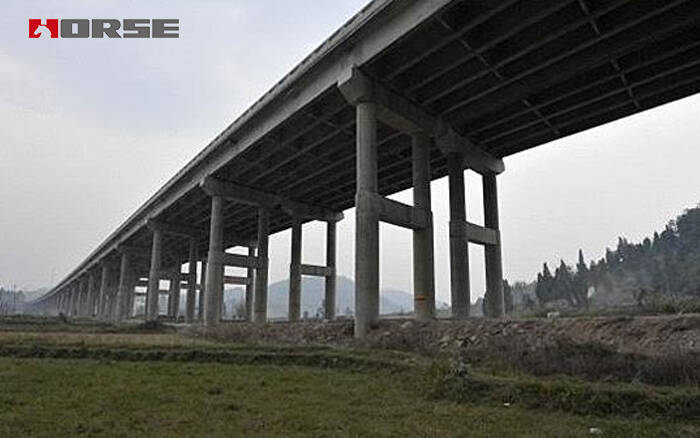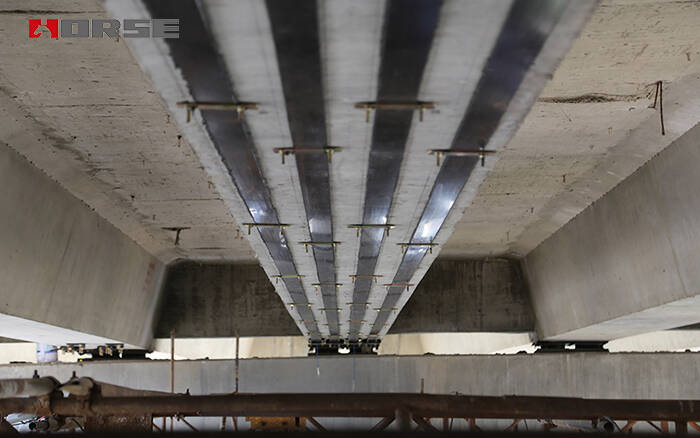Analysis and strengthening of cracks in beam and slab of Highway
Bridge strengthening
For highway bridges, there are five main types of cracks in beam and slab. We choose these measures to strengthening: steel plate strengthening, enlargement of cross section method, prestressed CFRP plate.

For highway bridges, there are five main types of cracks in beam and slab. There are also some differences in the causes of different types of cracks.
A vertical crack on the web
Oblique cracks on the web
Cracks in the lower edge of the drawing area
Longitudinal cracks at the bottom of the beam
Reticulate fissure
A vertical crack on the web
This is one of the most common crack types of road bridge plates. Generally, if the span of the beam is above 12M, most of the cracks will appear in the thin abdominal part, and the width of the cracks is mostly between the range of 0.15mm to 0.3mm. From the actual situation, the width of the crack is proportional to the span of the beam. The larger the span of the beam is, the wider the crack is. Under the action of the load, the cracks will gradually extend to the upper and lower ends; in addition, the cracks are generally larger in the span of the span, and the cracks will be narrowed after extending to the two sides. If the span of the beam is within 10m, the cracks will be relatively small, and most of the cracks are finer up by Liang Lei, and the upper end to the top of the web is small, and there are few cracks on the two ends of the web. The main reasons of this type of crack are as follows: in the design of Luqiao, the design is not in place, for example, the span of the beam is too large and the beam is higher; in the process of construction, the quality is not strictly checked, the quality of the project will have a certain effect. At the same time, in the later maintenance process, there will be problems that cause cracks in the beam plate, the influence of uncontrollable factors, such as the influence of ambient temperature, the influence of bad weather and so on.
Oblique cracks on the web
For web diagonal cracks, both sides are mostly concentrated in the mid span, and with the crack and cross the distance is, the crack inclination is greater.In general, the slope angle is within the range of 15 to 45 degrees. The cracks are gradually extended from the half height of the beam to the upper and lower ends of the beam, and the cracks are mostly from the lower flange to the upper edge, and the width of the cracks is relatively small. Most of the cracks are within 0.3mm. The main reasons of this type of crack are as follows: there are some defects in the design, because the concrete has certain shrinkage, which makes the beam produce micro cracks or the existence of certain initial tensile stress, thus the tensile zone of the web will also be affected to a certain extent.The specific performance of axial ratio calculation is low, thereby increasing the shear stress, principal tensile stress is caused by the calculation of concrete, once difficult to afford this pull stress, beam plate will produce cracks; in the construction process, the lack of adequate supervision of construction quality, the construction quality is poor, thus speeding up the crack growth.
Cracks in the lower edge of the drawing area
Most of this type of crack is concentrated in the central region of the beam span. In general, the larger the span of the beam, the more cracks appear, the growth trend of the cracks is gradually carried out from the lower flange, until the flange of the flange and the beam ribs stop. The width of this type of crack is mostly within the range of 0.03mm to 0.1mm. There are two main reasons for this type of crack, one is the shrinkage of concrete, the two is the deflection of the beam.
Longitudinal cracks and reticulation cracks on the bottom of the beam
Relatively few cases appear in the actual situation, which belong to individual phenomena. The direction of fracture is irregular and the crack width is very small. The main reasons are: the concrete protective layer is too thin or admixture of chlorine salt constant speed coagulant; the concrete surface appears to a certain degree of crack phenomenon; in the process of construction stratified pouring, the interval time is relatively long, thus causing the layer cracks in the approximate horizontal direction.
Reinforcement measures and Countermeasures for crack of beam and slab of Highway Bridge

Bonded steel plate by stuctural adhesive
The steel plate is fixed by a series of epoxy resin adhesive, and the steel plate is attached to the drawing edge or the weak part of the reinforced concrete structure, so that the steel plate is no longer alone, but a common force body is formed with the original structure, and then the rigidity of the whole body is improved. This method improves the stress state of the steel and concrete of the original structure to a certain extent, thus effectively restricting the development of the crack, and finally can realize the purpose of strengthening the beam and plate, and improve the carrying capacity of Luqiao effectively.
Enlarging the main beam cross section method
The effective measures are taken to increase the section and reinforcement of the component, and then the strength, stiffness and crack resistance of the component can be improved effectively, and the stability of the whole component is also promoted, thus the purpose of strengthening is achieved. This method can not only improve the bearing capacity of the original component, but also reduce the length and slenderness ratio of the original component, and increase the stiffness of the original member, so as to obtain further reinforcement effect.

Prestressed FRP laminate strengthening method
Beam, Slab of Flexural Strengthening
• improve the bearing capacity of bridge structure,has incomparable advantages in large-span beam slab of flexural reinforcement.
• significantly reduce deformation of the structure and improve the bearing capacity of structure,decrease the crack width and deflection deformation,and is suitable for large span beam slab of flexural reinforcement.
• improve the stiffness of structure ,and make full use of the material performance ,save a lot of materials and engineering cost.